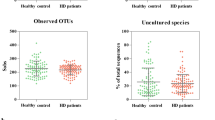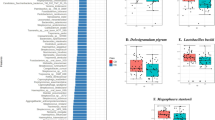Abstract
This study aimed at investigating the salivary microbiota of 28 patients affected by immunoglobulin A nephropathy (IgAN). Fourteen healthy volunteers (HC) were used as control. Compared to HC, the number of some cultivable bacteria groups (e.g., total anaerobes) significantly (P < 0.05) decreased in the salivary samples of IgAN patients. Total bacteria from salivary samples of IgAN patients and HC subjects were analyzed by pyrosequencing of 16S rRNA gene. Paired t test showed no significant (P > 0.05) differences of alpha-diversity parameters (OTU, ACE, Chao1, and Shannon index) between the salivary samples of HC and IgAN patients. The difference for the community structure was further analyzed using three phylogeny-based beta-diversity measures. Compared to HC, the ratio between Firmicutes/Proteobacteria markedly decreased in IgAN patients. Gemella haemolysins, Granulicatella adiacens, and Veillonella parvula were positively associated (P < 0.05) with HC. Within the phylum Bacteroidetes, Prevotella species (Prevotella nigrescens, Prevotella intermedia, Prevotella pallens, and Prevotella salivae) were the highest in HC. The only exception was for Prevotella aurantiaca. Compared to HC, the percentage of abundance of some species, belonging to Pasteurellaceae family (e.g., Haemophylus parainfluenzae), increased in IgAN patients. Fusobacteriaceae (Fusobacterium) and Corynebacterium sp. also differed between the salivary samples of HC and IgAN patients.




Similar content being viewed by others
References
Sekirov I, Russel SL, Antunes LCM, Finlay BB (2010) Gut microbiota in health and disease. Physiol Rev 90:859–904
Maukonen J, Matto J, Suihko ML, Saarela M (2008) Intra-individual diversity and similarity of salivary and faecal microbiota. J Med Microbiol 57:1560–1568
Bik ME, Long CD, Armitage GC, Loomer P, Emerson J et al (2010) Bacterial diversity in the oral cavity of ten healthy individuals. ISME J 4:962–974
Ling Z, Kong J, Jia P, Wei C, Wang Y et al (2010) Analysis of oral microbiota in children with dental caries by PCR-DGGE and barcoded pyrosequencing. Microb Ecol 60:677–690
Lockhart PB, Durak DT (1999) Oral microflora as a cause of endocarditis and other distant site infections. Infect Dis Clin N Am 13:833–850
Beck JD, Eke P, Heiss G, Manadios P, Couper D et al (2005) Periodontal disease and coronary heart disease: a reappraisal of the exposure. Circulation 112:19–24
Ahn J, Chen CY, Hayes RB (2012) Oral microbiome and oral and gastrointestinal cancer risk. Cancer Causes Control 23:399–404
Paju S, Scannapeico FA (2007) Oral biofilm, periodontitis, and pulmonary infections. Oral Dis 13:508–512
Koren O, Spor A, Felin J, Fak F, Stombaugh J et al (2011) Human oral, gut, and plaque microbiota in patients with atherosclerosis. Proc Natl Acad Sci U S A 108:4592–4598
Silva-Boghossian C, Castro GF, Teles RP, De Souza IP, Colombo AP (2008) Salivary microbiota of HIV-positive children and its correlation with HIV status, oral diseases, and total secretory IgA. Int J Pediatr Dent 18:205–216
Boggess KA, Beck JD, Murtha AP, Moss K, Offenbacher S (2006) Maternal periodontal disease in early pregnancy and risk for a small-for-gestational-age infant. Am J Obstet Gynecol 194:1316–1322
Akar H, Akar GC, Carrero JJ, Stenvinkel P, Lindholm B (2011) Systemic consequences of poor oral health in chronic kidney disease patients. Clin J Am Soc Nephrol 6:218–226
Craig RG, Kotanko P, Kamer AR, Levin NW (2007) Periodontal diseases–a modifiable source of systemic inflammation for the end-stage renal disease patient on haemodialysis therapy? Nephrol Dial Transplant 22:312–315
Moriyama T, Nitta K (2011) Tonsilletomy and steroid pulse therapy for IgA nefropathy. Tohoku J Exp Med 224:243–250
Nagasawa Y, Iio K, Fukuda S, Date Y, Iwatani H et al (2014) Periodontal disease bacteria specific to tonsil in IgA nephropathy patients predicts the remission by the treatment. PLoS One 9:e81636. doi:10.1371/journal.pone.0081636
Glassock RJ, Lee G (2009) Immunoglobulin A nephropathy. In: Ponticelli C, Glassock RJ (eds) Treatment of primary glomerulonephritis. Oxford University Press, Oxford, pp 313–361
Manno C, Strippoli GF, D’Altri C, Torres D, Rossini M et al (2007) A novel simpler histological classification for renal survival in IgA nephropathy: a retrospective study. Am J Kidney Dis 49:763–775
Kiryluk K, Novak J, Gharavi AG (2013) Pathogenesis of immunoglobulin A nephropathy: recent insight from genetic studies. Annu Rev Med 64:339–356
Glassock RJ (2011) The pathogenesis of IgA nephropathy. Curr Opin Nephrol Hypertens 20:153–160
Yu HH, Chu KH, Yang YH, Lee JH, Wang LC et al (2011) Genetics and immunopathogenesis of IgA nephropathy. Clin Rev Allerg Immunol 41:198–213
Soylu A, Kasap B, Soylu OB, Türkmen M, Kavukçu S (2007) Does feeding in infancy effect the development of IgA nephropathy? Pediatr Nephrol 22:1040–1044
McCarthy DD, Kujawa J, Wilson C, Papandile A, Poreci U et al (2011) Mice overexpressing BAFF develop a commensal flora-dependent, IgA-associated nephropathy. J Clin Investig 121:3991–4002
De Angelis M, Montemurno E, Piccolo M, Vannini L, Lauriero G et al (2014) Microbiota and metabolome associated with immunoglobulin A nephropathy (IgAN). PLoS One 9:e99006. doi:10.1371/journal.pone.0099006
Meng H, Ohtake H, Ishida A, Ohta N, Kakehata S (2012) IgA production and tonsillar focal infection in IgA nephropathy. J Clin Exp Hematop 52:161–170
Sharmin S, Shimizu Y, Hagiwara M, Hirayama K, Koyama A (2004) Staphylococcus aureus antigens induce IgA-type glomerulonephritis in Balb/c mice. J Nephrol 17:504–511
Yamamoto C, Suzuki S, Kimura H, Yoshida H, Gejyo F (2002) Experimental nephropathy induced by Haemophilus parainfluenzae antigens. Nephron 90:320–327
De Angelis M, Piccolo M, Vannini L, Siragusa S, De Giacomo A et al (2013) Fecal microbiota and metabolome of children with autism and pervasive developmental disorder not otherwise specified. PLoS One 8:e76993. doi:10.1371/journal.pone.0076993
Suchodolski JS, Dowd SE, Wilke V, Steiner JM, Jergens AE (2012) 16S rRNA gene pyrosequencing reveals bacterial dysbiosis in the duodenum of dogs with idiopathic inflammatory bowel disease. PLoS One 7:e39333. doi:10.1371/journal.pone.0039333
Gontcharova V, Youn E, Wolcott RD, Hollister EB, Gentry TJ et al (2010) Black box chimera check (B2C2): a windows-based software for batch depletion of chimeras from bacterial 16S rRNA gene datasets. Open Microbiol J 4:47–52
Dowd SE, Zaragoza J, Rodriguez JR, Oliver MJ, Payton PR (2005) Windows.NET network distributed basic local alignment search toolkit (W.ND-BLAST). BMC Bioinf 6:93
Edgar RC (2010) Search and clustering orders of magnitude faster than BLAST. Bioinformatics 26:2460–2461
Cole JR, Wang Q, Cardenas E, Fish J, Chai B et al (2009) The ribosomal database project: improved alignments and new tools for rRNA analysis. Nucleic Acids Res 37:D141–D145. doi:10.1093/nar/gkn879
Scannapieco FA (2013) The oral microbiome: its role in health and in oral and systemic infections. Clin Microbiol Newsl 35:163–169
Kumar PS, Griffen AL, Moeschberger ML, Leys EJ (2005) Identification of candidate periodontal pathogens and beneficial species by quantitative 16S clonal analysis. J Clin Microbiol 43:3944–3955
Petersen PE (2003) The world oral health report 2003: continuous improvement of oral health in the 21st century-the approach of the WHO global oral health programme. Community Dent Oral Epidemiol 31:3–23
Ling Z, Xia L, Yuezhu W, Lanjuan L, Xiang C (2013) Pyrosequencing analysis of the salivary microbiota of healthy Chinese children and adults. Microb Ecol 65:487–495
Huttenhower C, Gevers D, Knight R, Abubucker S, Badger JH (2012) Structure, function and diversity of the healthy human microbiome. Nature 486:207–214
Huse S, Ye Y, Zhou Y, Fodor AA (2012) A core human microbiome as viewed through 16S rRNA sequence clusters. PLoS One 7:e34242. doi:10.1371/journal.pone.0034242
Francavilla R, Ercolini D, Piccolo M, Vannini L, Siragusa S et al (2014) Salivary microbiota and metabolome associated with celiac desease. Appl Environ Microbiol 80:3416–3425
Takeshita T, Nakano Y, Kumagai T, Yasui M, Kamio N et al (2009) The ecological proportion of indigenous bacterial populations in saliva is correlated with oral health status. ISME J 3:65–78
Eitner F, Floege J (2008) Bacterial protease for the treatment of IgA nephropathy. Nephrol Dial Transplant 23:2173–2175
Acknowledgments
This study was partly supported by Immunonephrology Working Group ERA-EDTA. We thank Sonya Siragusa (Department of Soil, Plant and Food Sciences, University of Bari Aldo Moro, Bari, Italy) and Valentina Maranzano (DETO, Nephrology Unit–University of Bari Aldo Moro, Bari) for technical assistance.
Author information
Authors and Affiliations
Corresponding author
Rights and permissions
About this article
Cite this article
Piccolo, M., De Angelis, M., Lauriero, G. et al. Salivary Microbiota Associated with Immunoglobulin A Nephropathy. Microb Ecol 70, 557–565 (2015). https://doi.org/10.1007/s00248-015-0592-9
Received:
Accepted:
Published:
Issue Date:
DOI: https://doi.org/10.1007/s00248-015-0592-9




